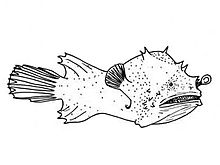Photocorynus
| Photocorynus | |
|---|---|

| |
| Female P. spiniceps | |
| Scientific classification | |
| Domain: | Eukaryota |
| Kingdom: | Animalia |
| Phylum: | Chordata |
| Class: | Actinopterygii |
| Order: | Lophiiformes |
| Family: | Linophrynidae |
| Genus: | Photocorynus Regan, 1925 |
| Species: | P. spiniceps
|
| Binomial name | |
| Photocorynus spiniceps Regan, 1925
| |
Photocorynus spiniceps is a species of anglerfish in the family Linophrynidae.[1][2] It is in the monotypic genus Photocorynus. Photocorynus spiniceps originates from the Philippines.[3]
The known mature male individuals are 6.2–7.3 millimeters (0.25-0.3 inches), smaller than any other mature fish and vertebrate; the females, however, reach a significantly larger size of up to 50.5 millimeters (2 inches).[4][5] Numerous fish species have both sexes reaching maturity below 20 millimeters (0.8 inches).[6]
Like most other deepsea anglerfishes, Photocorynus spiniceps lures its prey into striking range using a bioluminescent sac at the end of an illicium, the highly modified first ray of the dorsal fin, and swallows the prey whole with the help of a distending jaw and a similarly distending stomach. Its prey can sometimes be as big as their own bodies. The male spends its life fused to its much larger female counterpart, therefore effectively turning her into a hermaphrodite. It is important to note that the male has to bite the female in order to spend the rest of its life fused together.[7]
While the female takes care of swimming and eating, the male, with a large proportion of its body consisting of testes, is charged with the task of aiding reproduction.
See also
[edit]References
[edit]- ^ Charles Tate Regan (1925). "Dwarfed Males Parasitic on the Females in Oceanic Angler-Fishes (Pediculati Ceratioidea)". Proceedings of the Royal Society B. 97 (684): 386–400. Bibcode:1925RSPSB..97..386T. doi:10.1098/rspb.1925.0006.
- ^ Froese, Rainer; Pauly, Daniel (eds.) (2006). "Photocorynus spiniceps" in FishBase. February 2006 version.
- ^ Kessler, R. (2006). Fish Story in Reverse. Natural History, 115(3), 32.
- ^ Theodore W. Pietsch (2005). "Dimorphism, parasitism, and sex revisited: modes of reproduction among deep-sea ceratioid anglerfishes (Teleostei: Lophiiformes)". Ichthyological Research. 52 (3): 207–236. Bibcode:2005IchtR..52..207P. doi:10.1007/s10228-005-0286-2. S2CID 24768783.
- ^ Doughton, Sandi (January 31, 2001). "Catch of the day: Researcher stakes claim to tiny-fish title". The Seattle Times. Archived from the original on 18 May 2008. Retrieved 2 February 2006.
- ^ S. H. Weitzman & R. P. Vari (1988). "Miniaturization in South American freshwater fishes; an overview and discussion". Proceedings of the Biological Society of Washington. 101: 444–465.
- ^ Kessler, R. (2006). Fish Story in Reverse. Natural History, 115(3), 32.
- "Photocorynus spiniceps". Integrated Taxonomic Information System. Retrieved 18 April 2006.
External links
[edit]
